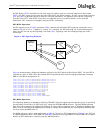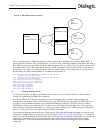
140
Chapter 7 Configuration Overview
A Destination Point (DEST) can route a message to an Application Server (AS) or to MTP (using MTP2 or
M2PA SS7 links) for routing based on Point Code. MTP routing can be selected by specifying an RTPRI of MTP.
AS routing can be selected by specifying an RTPRI of NONE and identifying the AS that the messages should
be routed to. Destinations are managed using the SGDPx commands.
It is worth noting that in many configurations, routing key analysis is not required and the user can configure
an Incoming Route to go directly to a Destination without having to explicitly provide routing key
information, such as Destination Point Codes, for every eventual destination.
Figure 9. Routing Configuration Example
Figure 9 demonstrates example relationships between entities in the routing model. Relationships with full
lines indicate that there is an explicit relationship between the entities (that is, one entity selects the other).
Relationships with dotted lines indicate that the relationship is implicit, for example, if data arrives on a
SIGTRAN link over M3UA, it is implicitly coming from the SIGTRAN IP domain and similarly if data arrives on
an SS7 link set, it is implicitly arriving from the MTP domain.
Note: A message arriving from M2PA is considered as arriving from the MTP domain.
This example identifies two incoming routes, IR 1 from SIGTRAN IP and IR 2 from the MTP side. IR 1 and
IR 2 go to the Routing Key Table 1 for routing key analysis. If the analysis fails, or the destination found by
the analysis (Application Server AS1) is out of service, the Signaling Gateway discards messages from IR 1.
The Signaling Gateway however attempts to route messages from IR 2 to Destination 2 only discards those
messages if the SS7 route C7RT 1 is also out of service.
This example identifies two incoming routes, IR 1 from SIGTRAN IP and IR 2 from the MTP side. IR 1 goes to
Routing Key Table 1 for routing key analysis. IR 2 also goes to Routing Key Table 1 for analysis, however, if
analysis fails, or the destination found by analysis (either a MTP or SIGTRAN IP route or Application Server)
is out of service, it attempts to route to Destination 2.
The routing key table has one entry as follows:
• The entry that routes all SS7 messages with DPC 2 and CICs 1 to 128 to Destination 1.
There are two Destinations:
• Destination 1 routes to Application Server 1.
• Destination 2 routes all messages to the MTP side.
Example MML for the routing part of the above configuration is as follows:
Note: The Destinations Point are configured first, followed by the Routing Key Tables, and then finally
the Incoming Routes.
SGDPI:DEST=1,RTPRI=NONE,AS=1;
SGDPI:DEST=2,RTPRI=MTP;
SGRKI:RKI=1,RKTAB=1,DPC=2,BCIC=1,RANGE=128,NC=1,DEST=1;
SGIRI:IR=1,NC=1,DOMAIN=IP,RKTAB=1;
SGIRI:IR=2,NC=1,DOMAIN=MTP,RKTAB=1,DEST=2;
IR1
IR2
RK1
DEST1
DEST2
AS1
C7RT 1
LS
Signaling Gateway
Application
Server
DPC 2
CICs 1 to 128
DPC 3


















